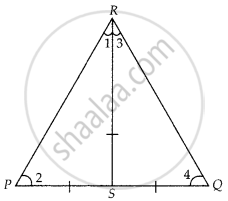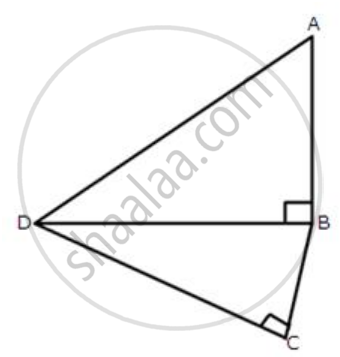Advertisements
Advertisements
प्रश्न
If S is a point on side PQ of a ΔPQR such that PS = QS = RS, then ______.
विकल्प
PR . QR = RS2
QS2 + RS2 = QR2
PR2 + QR2 = PQ2
PS2 + RS2 = PR2
उत्तर
If S is a point on side PQ of a ΔPQR such that PS = QS = RS, then PR2 + QR2 = PQ2.
Explanation:

Given, in ∆PQR,
PS = QS = RS ...(i)
In ∆PSR,
PS = RS ...[From equation (i)]
⇒ ∠1 = ∠2 ...(ii) [Angles opposite to equal sides are equal]
Similarly, in ∆RSQ,
RS = SQ
⇒ ∠3 = ∠4 ...(iii) [Angles opposite to equal sides are equal]
Now, in ∆PQR,
Sum of angles = 180°
⇒ ∠P + ∠Q + ∠P = 180°
⇒ ∠2 + ∠4 + ∠1 + ∠3 = 180°
⇒ ∠1 + ∠3 + ∠1 + ∠3 = 180°
⇒ 2(∠1 + ∠3) = 180°
⇒ ∠1 + ∠3 = `180^circ/2` = 90°
∴ ∠R = 90°
In ∆PQR, by Pythagoras theorem,
PR2 + QR2 = PQ2
APPEARS IN
संबंधित प्रश्न
Nazima is fly fishing in a stream. The tip of her fishing rod is 1.8 m above the surface of the water and the fly at the end of the string rests on the water 3.6 m away and 2.4 m from a point directly under the tip of the rod. Assuming that her string (from the tip of her rod to the fly) is taut, ho much string does she have out (see Figure)? If she pulls in the string at the rate of 5 cm per second, what will be the horizontal distance of the fly from her after 12 seconds?

The diagonals of a rhombus measure 16 cm and 30 cm. Find its perimeter.
Find the length diagonal of a rectangle whose length is 35 cm and breadth is 12 cm.
The given figure shows a quadrilateral ABCD in which AD = 13 cm, DC = 12 cm, BC = 3 cm and ∠ABD = ∠BCD = 90o. Calculate the length of AB.
In the following figure, AD is perpendicular to BC and D divides BC in the ratio 1: 3.
Prove that : 2AC2 = 2AB2 + BC2
In figure AB = BC and AD is perpendicular to CD.
Prove that: AC2 = 2BC. DC.
O is any point inside a rectangle ABCD.
Prove that: OB2 + OD2 = OC2 + OA2.
In a rectangle ABCD,
prove that: AC2 + BD2 = AB2 + BC2 + CD2 + DA2.
A flag pole 18 m high casts a shadow 9.6 m long. Find the distance of the top of the pole from the far end of the shadow.
In a quadrilateral ABCD, ∠A + ∠D = 90°. Prove that AC2 + BD2 = AD2 + BC2
[Hint: Produce AB and DC to meet at E.]
